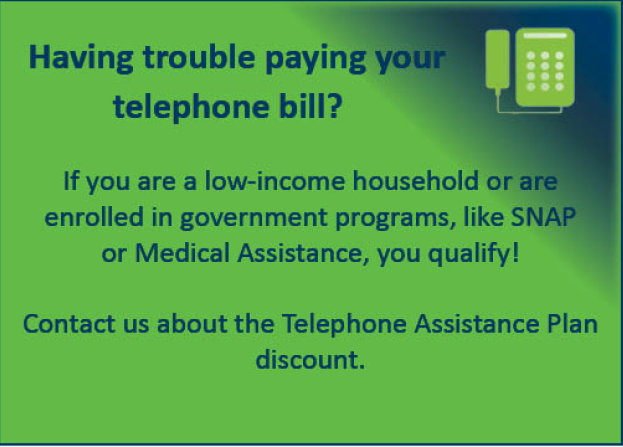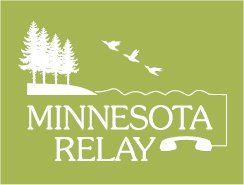Assistance Programs
These programs are available for customers with telephone service.
Federal Lifeline
The Federal Communications Commission’s (FCC) Lifeline Program provides up to a $9.25 monthly discount on telephone service for Americans whose income falls below certain guidelines. Following is information about the program and how it works.
Eligibility Guidelines If your income level falls at or below 135% of the Federal Poverty Guidelines, you will qualify for discounted telephone service under the terms of the FCC’s Lifeline Program. Consumers will also be eligible to receive the discount if they’re receiving assistance from at least one of the following programs: Supplemental Nutrition Assistance Program (SNAP), Medicaid, Federal Public Housing Assistance (FPHA), Supplemental Security Income (SSI) and Veterans Pension or Survivors Pension Benefit.
Enrollment Information There are three ways to apply for Lifeline
- Apply online at www.lifelinesupport.org
- Mail in your application. Print an application https://www.usac.org/wp-content/uploads/lifeline/documents/forms/LI_Application_NVstates.pdf
- Complete the application and send with proof of eligibility to
USAC
Lifeline Support Center
PO Box 1000
Horseheads, NY 14845 - Come into our office and we can assist you
Once you have been approved, please provide us with the approval documentation to get the discount added to your account.
For more information about the program, go to their website at https://www.fcc.gov/general/lifeline-program-low-income-consumers
Affordable Connectivity Program (ACP) - Effective February 8th, 2024 the Affordable Connectivity Program is no longer available
The Affordable Connectivity Program is a Federal Communications Commission program that helps connect families and households struggling to afford internet service. This new benefit provides a discount of up to $30 per month toward broadband service for eligible households.
A household is eligible if one member of the household meets at least one of the following criteria:
- Has an income that is at or below 200% of the Federal Poverty Guidelines;
- Participates in certain assistance programs, such as SNAP, Medicaid, Federal Public Housing Assistance, SSI, WIC, or Lifeline;
- Participates in one of several Tribal specific programs, such as Bureau of Indian Affairs General Assistance, Tribal Head Start (only households meeting the relevant income qualifying standard) Tribal TANF, or Food Distribution Program on Indian Reservations;
- Is approved to receive benefits under the free and reduced-price school lunch program or the school breakfast program, including through the USDA Community Eligibility Provision;
- Received a Federal Pell Grant during the current award year; or
- Meets the eligibility criteria for a participating broadband provider’s existing low-income program.
Eligible households can enroll by going to www.getinternet.gov (Spanish version at www.accedeainternet.gov ) to submit an application or print a mail-in application or come into our office and we can help you.
Once you have been approved, please provide us with the approval documentation and we will get the discount added to your account.
For more information on the Affordable Connectivity Program, please go to https://www.fcc.gov/acp
Minnesota Telephone Assistance Plan
The Minnesota Telephone Assistance Plan (TAP) helps make telephone service affordable to low-income consumers.
Eligibility Guidelines
If your income level falls at or below 135% of the Federal Poverty Guidelines, you will qualify for discounted telephone service under the terms of the FCC’s Lifeline Program. Consumers will also be eligible to receive the discount if they’re receiving assistance from at least one of the following programs: Supplemental Nutrition Assistance Program (SNAP), Medicaid, Federal Public Housing Assistance (FPHA), Supplemental Security Income (SSI) and Veterans Pension or Survivors Pension Benefit.
How do I apply?
To get the current application for this program, please click HERE
For more information on TAP, click HERE
Runestone Telecom Association can assist you with the application or you can contact the Minnesota Public Utilities Commission for assistance at consumer.puc@state.mn.us

Telephone Equipment Distribution (TED)
This program provides free specialized telecommunications equipment to income-eligible Minnesotans who are having trouble using the telephone due to a hearing, speech or physical disability.
For more information on the TED program, call
1-800-657-3663 (voice)
1-888-206-6555 (TTY)
or go to the website click here
Minnesota Relay
 Phone family, friends or vital services even if you have a hearing, speech or physical disability. Minnesota Relay is a free service, providing full telephone accessibility for anyone who is hard of hearing, deaf or speech disabled, through the use of specially trained communications assistants (CA). Available 24 hours a day, 365 days a year. Call next door or internationally. Calls are 100% confidential.
Phone family, friends or vital services even if you have a hearing, speech or physical disability. Minnesota Relay is a free service, providing full telephone accessibility for anyone who is hard of hearing, deaf or speech disabled, through the use of specially trained communications assistants (CA). Available 24 hours a day, 365 days a year. Call next door or internationally. Calls are 100% confidential.
Now it is easier than ever to make a Minnesota Relay call….Just dial 7-1-1. Once connected to the relay service, tell the CA the type of relay call you want to make. Or, dial the specific toll free number for the type of relay call you want to make.
Services available are:
Captioned Telephone Service (CTS)
CTS uses a special telephone with a text display screen so that a person who is hard of hearing can listen to and read captions of everything the other person on the call says. You speak directly to the other person on the call, and a relay communications assistant transcribes everything the other person says into captions, which appear on the display screen of your CTS phone.
Internet Protocol Captioned Telephone Service (IP CTS)
Internet-based forms of CTS are available for those who would like to use CTS on a computer, tablet, or smartphone. Go to: www.fcc.gov/consumers/guides/internet-protocol-ip-captioned-telephone-service.
Computer (ASCII): 1-800-627-3529
Computer users can access Minnesota Relay. Set your communications software to the following protocols: speeds ranging from 300 to 2400; 8 Bits; No Parity; 1 Stop Bit; Full Duplex. When calling at a rate of 300 or below, follow the above using Half Duplex.
Hearing Carry Over (HCO): 1-800-627-3529
HCO allows a person who can hear clearly but who has very limited or no speech capability to make and receive phone calls. Using a special text telephone, you type your conversation for the relay communications assistant to read to the other person, and listen directly to the other person’s response.
Hearing User: 1-800-627-3529
A hearing person may use a standard telephone or mobile phone to place a relay call and speak with a person who is deaf, hard of hearing, or speech disabled.
Internet Protocol (IP) Relay:
IP Relay combines text-based relay service with the ease of the internet – no need for a TTY. You are able to make your relay call using a computer, laptop, tablet, or smartphone. Go to: www.sprintrelay.com/sprintiprelay.
Spanish Relay: 1-877-627-5448
Spanish speaking persons with a hearing or speech disability are able to make relay calls. This is not a translation service – both parties must speak Spanish, and at least one party must have a hearing or speech disability.
Speech-to-Speech (STS): 1-877-627-3848
STS allows a person who has difficulty speaking or being understood on the phone to communicate using his or her own voice or voice synthesizer. The relay communications assistant revoices your words so that the other person on the call can understand them, and the other person speaks directly to you.
Text-Telephone (TTY): 1-800-627-3529
This service allows a person who is deaf, deafblind, or speech disabled to use a TTY to communicate with the other person on the call.
Video Relay Service (VRS)
VRS allows a person who uses American Sign Language (ASL) to communicate over the phone. The VRS user connects to the relay communications assistant via an internet-enabled device with a video camera. The communications assistant relays the conversation back and forth between the parties – in ASL with the VRS user and by voice with the called party. Go to: www.fcc.gov/consumers/guides/video-relay-services.
Voice Carry Over (VCO): 1-877-627-3024
VCO allows a person with a hearing disability, but who wants to use his or her own voice, to speak directly to the other party. The communications assistant then types the other party’s response, which is displayed on the VCO user’s text telephone.
Important Information
Emergency Assistance
TTY callers should dial 9-1-1 directly in an emergency. All 9-1-1 centers are equipped to handle TTY calls. Minnesota Relay can process emergency calls, but this may delay the response to your call.
To File a Complaint Regarding Minnesota Relay
Email your complaint to mn.relay@state.mn.us or call 1-800-657-3775. When filing your complaint please provide:
- Date and time of the relay call
- Calling from and to phone numbers
- CA’s identification number
- Nature of your complaint
You may also file a complaint with the Federal Communications Commission:
- Website: fcc.gov
- Voice: 1-888-225-5322
- TTY: 1-888-835-5322
- ASL via VP: 1-844-432-2275

